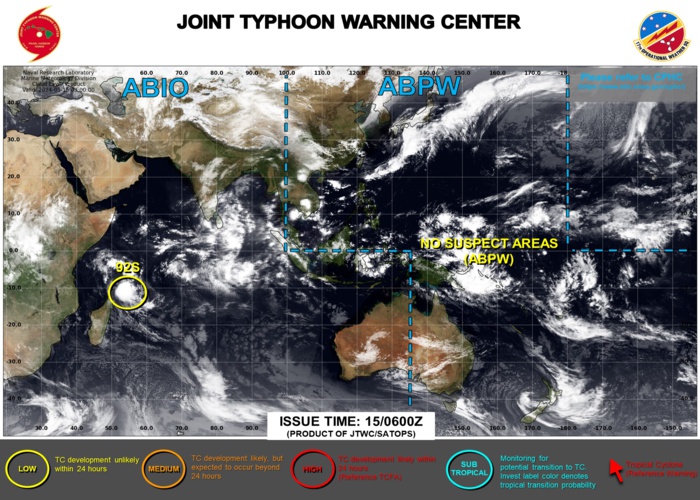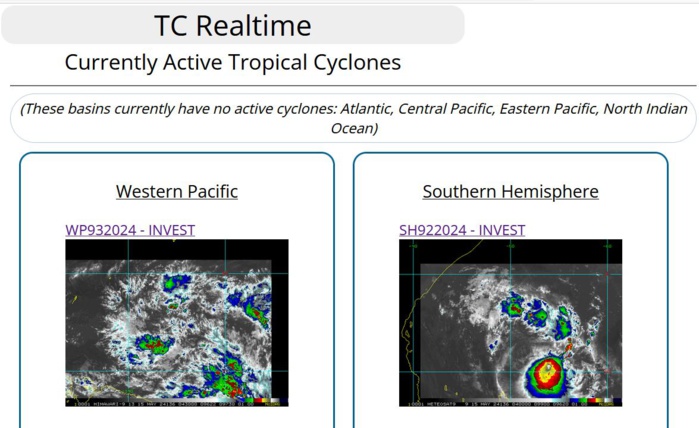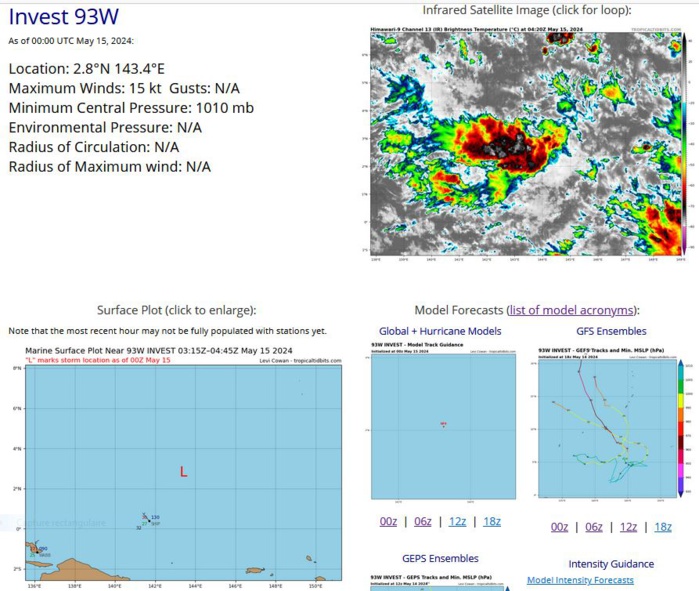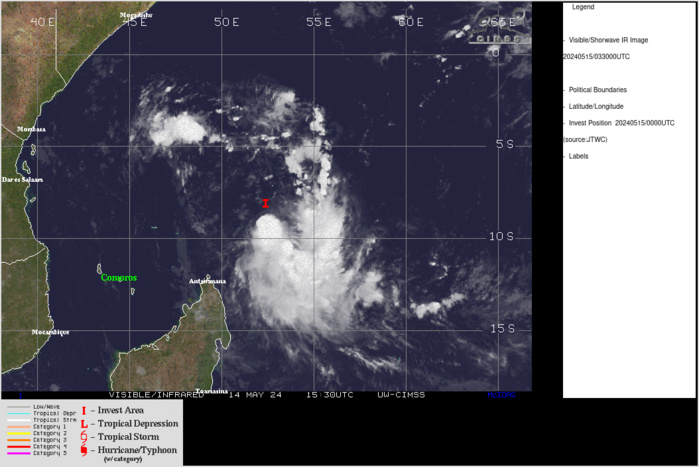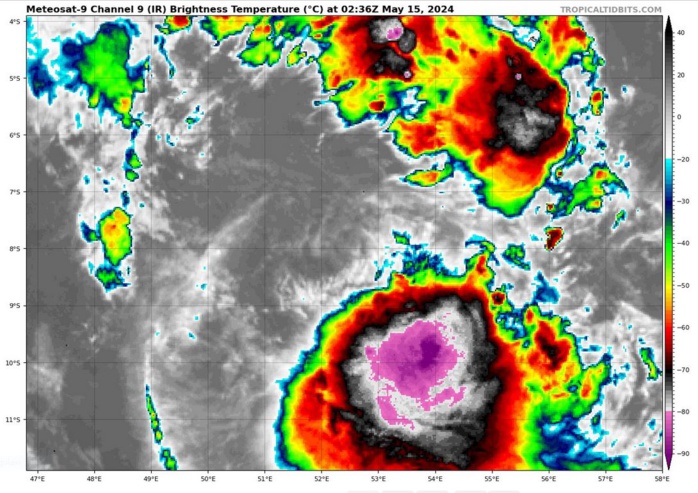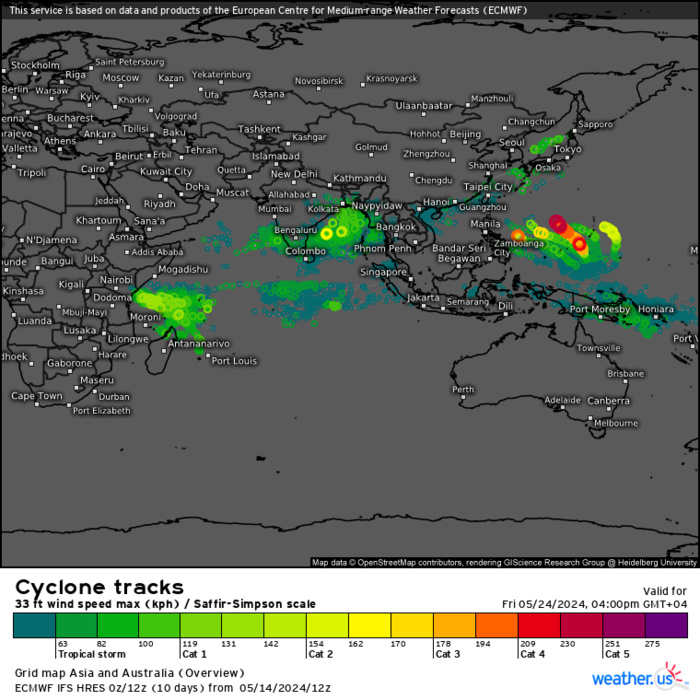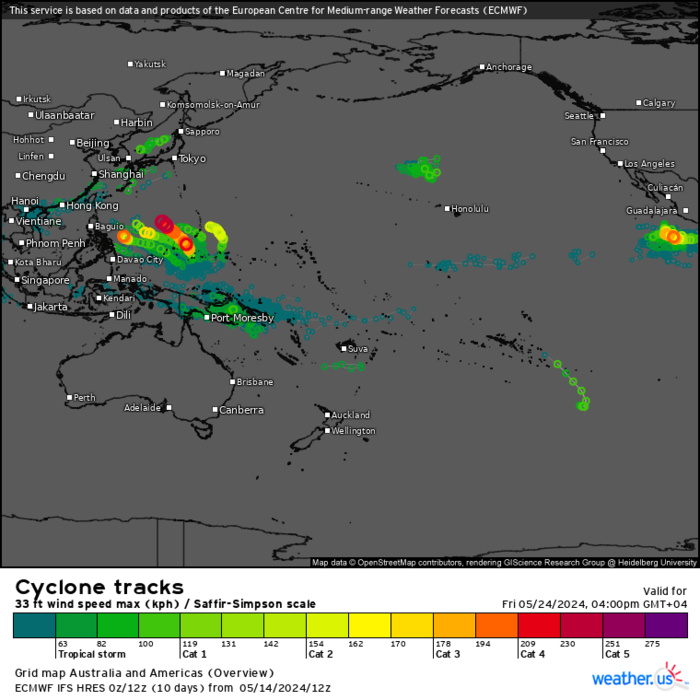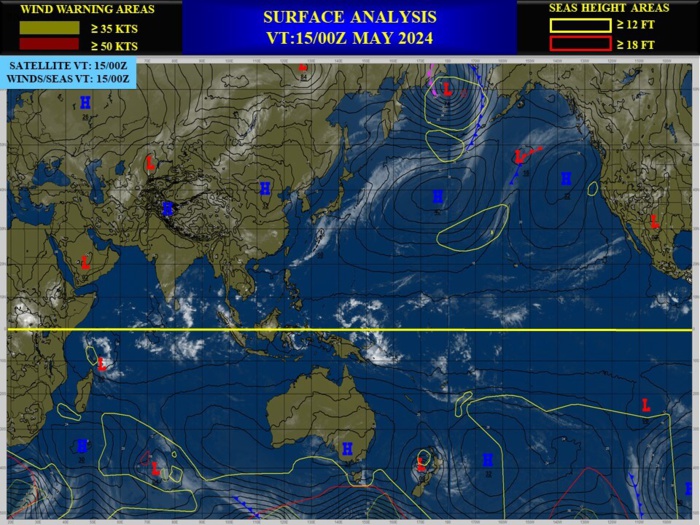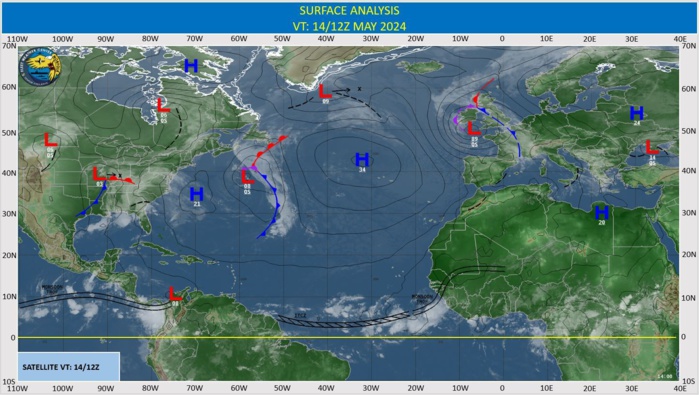CLICK ON THE IMAGERIES BELOW TO GET THEM ENLARGED
WESTERN NORTH PACIFIC: INVEST 93W. ESTIMATED LOCATION AND INTENSITY AT 15/00UTC. INTENSITY IS 15 KNOTS.
SOUTH INDIAN OCEAN: INVEST 92S. ESTIMATED LOCATION AND INTENSITY AT 15/00UTC. INTENSITY IS 25 KNOTS. ADVISORY(ABIO) ISSUED AT 14/18UTC.
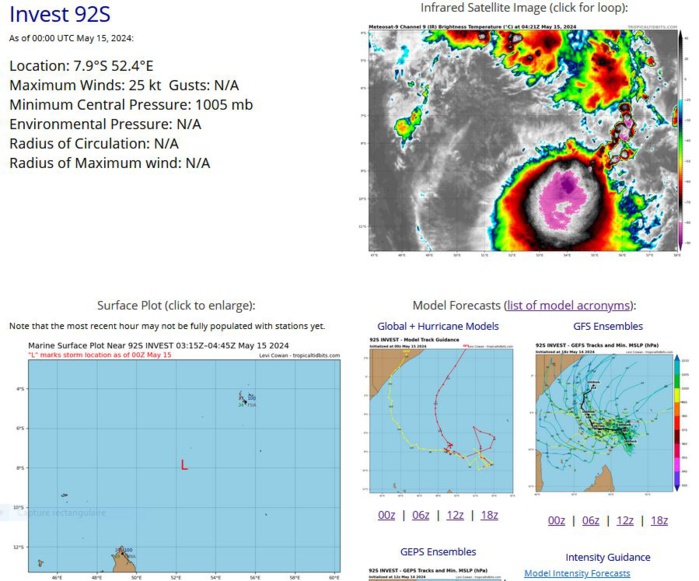
THE AREA OF CONVECTION (INVEST 92S) PREVIOUSLY LOCATED NEAR 9.7S 53.1E IS NOW LOCATED NEAR 9.7S 53.0E, APPROXIMATELY 395 NM EAST OF ALDABRA. ANIMATED ENHANCED INFRARED SATELLITE IMAGERY (EIR) AND A 140954Z AMSRZ 89GHZ MICROWAVE IMAGE DEPICTS A POORLY ORGANIZED LOW LEVEL CIRCULATION CENTER (LLCC) WITH ASYMMETRIC CIRCULATION. ENVIRONMENTAL ANALYSIS REVEALS A FAVORABLE ENVIRONMENT FOR FURTHER DEVELOPMENT WITH LOW TO MODERATE (15-20KT) VWS, GOOD UPPER-LEVEL OUTFLOW POLEWARD, AND WARM (29-30C) SEA SURFACE TEMPERATURES (SST). DETERMINISTIC MODELS ARE IN AGREEMENT THAT THE CIRCULATION WILL CONTINUE TO SLOWLY DEVELOP OVER THE NEXT 24 HOURS. MAXIMUM SUSTAINED SURFACE WINDS ARE ESTIMATED AT 23 TO 28 KNOTS. MINIMUM SEA LEVEL PRESSURE IS ESTIMATED TO BE NEAR 1004 MB. THE POTENTIAL FOR THE DEVELOPMENT OF A SIGNIFICANT TROPICAL CYCLONE WITHIN THE NEXT 24 HOURS REMAINS LOW.
CLICK ON THE IMAGERY BELOW TO GET IT ANIMATED AND ENLARGED
Model Diagnostic Plot
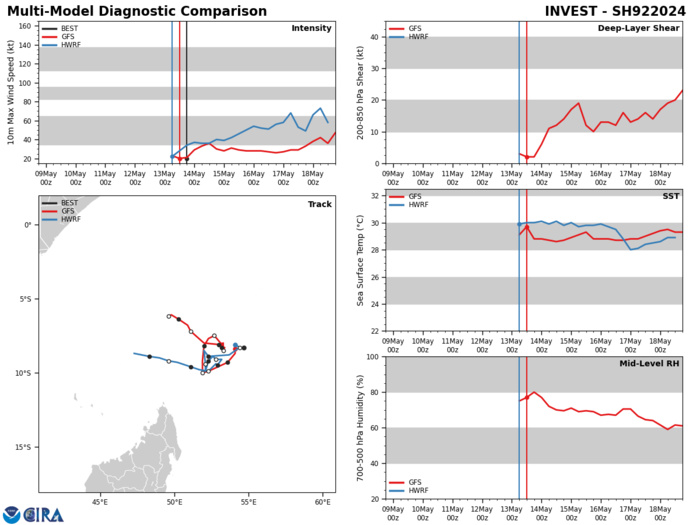
DETERMINISTIC MODELS ARE IN AGREEMENT THAT THE CIRCULATION WILL CONTINUE TO SLOWLY DEVELOP OVER THE NEXT 24 HOURS.
UPDATED SATELLITE BULLETIN AT 15/0230UTC
TPXS10 PGTW 150312
A. TROPICAL DISTURBANCE 92S (NE OFMADAGASCAR)
B. 15/0230Z
C. 7.87S
D. 52.56E
E. THREE/MET9
F. T1.5/1.5/D0.5/24HRS STT: S0.0/03HRS
G. IR/EIR
H. REMARKS: 24A/PBO SM EMBD CNTR/ANMTN. LOOSELY DEFINED CLOUD LINES
WITH COLD OVERCAST GREATER THAN 90NM ACROSS YIELD A DT OF 1.5. MET
YIELDS 1.5. PT YIELDS 2.0. DBO DT.
I. ADDITIONAL POSITIONS:
14/2134Z 8.47S 52.38E ATMS
14/2220Z 8.08S 52.35E AMS2
SWANSON
A. TROPICAL DISTURBANCE 92S (NE OFMADAGASCAR)
B. 15/0230Z
C. 7.87S
D. 52.56E
E. THREE/MET9
F. T1.5/1.5/D0.5/24HRS STT: S0.0/03HRS
G. IR/EIR
H. REMARKS: 24A/PBO SM EMBD CNTR/ANMTN. LOOSELY DEFINED CLOUD LINES
WITH COLD OVERCAST GREATER THAN 90NM ACROSS YIELD A DT OF 1.5. MET
YIELDS 1.5. PT YIELDS 2.0. DBO DT.
I. ADDITIONAL POSITIONS:
14/2134Z 8.47S 52.38E ATMS
14/2220Z 8.08S 52.35E AMS2
SWANSON
ECMWF Storm Tracks (Ensemble) : 05/14 12UTC+ 10 DAYS
ECMWF Storm Tracks (Ensemble) : 05/14 12UTC+ 10 DAYS
Last Updated - 05/14/24 3 WEEK TROPICAL CYCLONE FORMATION PROBABILITY
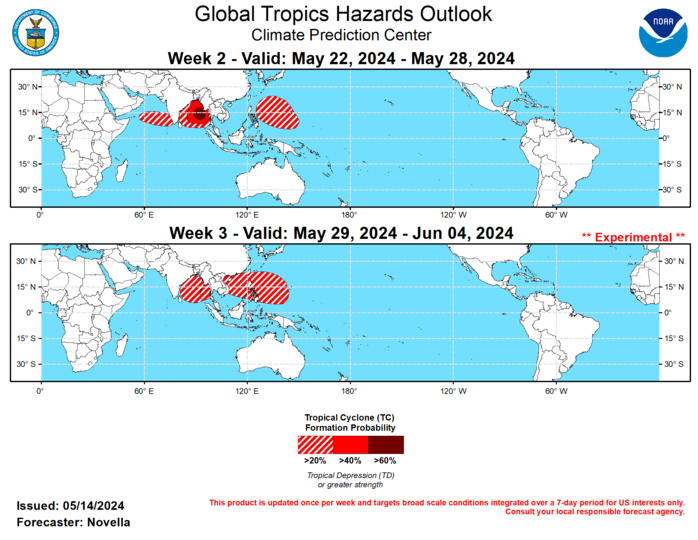
GTH Outlook Discussion Last Updated - 05/14/24 Valid - 05/22/24 - 06/04/24 Following a brief period of more coherent Madden-Julian Oscillation (MJO) activity during late April, the MJO has since weakened and became increasingly disorganized. The observed upper-level velocity potential anomaly fields depict a poor representation of the enhanced divergence envelope crossing the western Hemisphere, where there appears to be two other convective centers throughout the global tropics; one tied to a low frequency response in the western Indian Ocean, and another tied to Kelvin wave activity moving over the tropical Americas. The multiple centers of action have led to a much weakened signal in RMM space, as other modes of tropical variability have played a superseding role in driving convective and circulation anomalies during the past week or so. Moving forward, however, there is growing support in the RMM forecasts for renewed MJO activity during the next week, with the enhanced phase propagating eastward from the Indian Ocean and crossing the Maritime Continent at a potentially moderate amplitude through the end of May. The amplifying MJO signal in RMM space over the Indian Ocean may, in part, be explained by constructive interference with the aforementioned modes of tropical variability in the basin, and consequently, there is still some question as to the potential coherence of the MJO with other modes of tropical variability favored to remain at play during the next several weeks. There is also uncertainty in regards to MJO phase speed, as upper-level velocity potential anomaly forecasts in the GEFS and ECMWF depict very different placements of the enhanced and suppressed convective envelopes by the end of the month. A slower, and more canonical phase speed favored in the GEFS may be in response to monsoonal circulations taking shape over Asia and Africa, though the Kelvin wave-like MJO phase speed featured in the ECMWF has been the predominant mode this spring. Despite these uncertainties, the large-scale circulation looks conducive for tropical cyclogenesis in the northern Indian Ocean and western Pacific later in May. Conversely, more unfavorable conditions for Tropical Cyclone (TC) development are anticipated over the tropical Americas following a potentially early start of the Hurricane season in the eastern Pacific during week-1. No tropical cyclones formed during the past week. For week-1, the Joint Typhoon Warning Center (JTWC) is monitoring a tropical disturbance (92S) to the north of Madagascar. While formation chances are currently designated as low in the near-term, deterministic solutions have been fairly bullish for gradual development later this week. Any TC formation during this time of the year in the southwestern Indian Ocean would be very unusual, but is suggestive of the increasingly favorable conditions becoming established in the Indian Ocean. In the western Hemisphere, the National Hurricane Center (NHC) has yet to start issuing their regular Tropical Weather Outlooks (TWOs) with the start of the eastern Pacific Hurricane season beginning tomorrow (5/15). However, there is good continuity and support in the probabilistic TC genesis tools and raw ensembles for potential TC formation to the south of Mexico during mid to late week-1 before the suppressed phase of the MJO strengthens overhead. For week-2, both the GEFS and ECMWF favor a band of strongly anomalous lower-level westerlies expanding eastward throughout the equatorial Indian Ocean tied to the renewed MJO. With anomalous easterlies favored to the north to induce a broad region of cyclonic flow, this results in elevated TC formation chances over the northern Indian Ocean during week-2. Based on climatology, and continued support in the probabilistic TC genesis tools, 60% chances for development are posted in the Bay of Bengal, with 20% chances in the Arabian Sea. Notably, strongly positive SST anomalies are observed throughout the entire basin, with some parts registering over 31 degrees C in the weekly mean which could provide plenty of fuel for any TCs that develop. These tools also show modest signals for additional development to the south of the equator between 70E and 80E, though given climatology for late May, there is not enough confidence to post a corresponding TC area for week-2. In the western Pacific, 20% chances for TC development are posted in the Philippine Sea in association with an equatorial Rossby wave forecast and support in the raw ensembles. Higher chances were considered, however odds for development are highest in the tools late in week-1, and any areas of low pressure may struggle to intensify with increased shear favored in the GEFS near the Marianas. Should the MJO maintain coherence while propagating eastward across the Maritime Continent and possibly reach the Western Pacific during week-3, this would continue to favor additional TC development in the northern Indian Ocean and western Pacific based on historical MJO/TC composites. Therefore, 20% chances are posted across the Bay of Bengal and western Pacific which is consistent with signals in the probabilistic tools for week-3. These tools also point to reemerging signals in the eastern Pacific and Caribbean by the start of June. While TC genesis is certainly possible associated with transient equatorial Kelvin and/or Rossby waves that develop, no corresponding TC areas are posted in the outlook as TC formation would become more favorable later during the week-4 timeframe, even with the faster MJO propagation speed featured in the ECMWF.
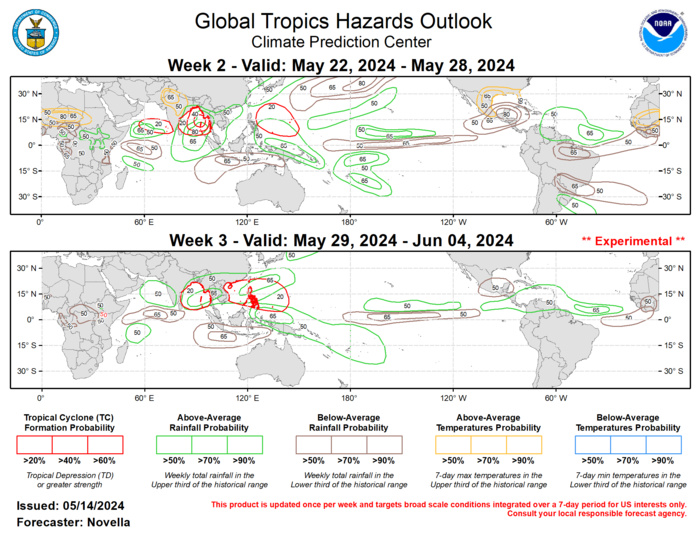
The precipitation outlooks for weeks 2 and 3 are based on a historical skill weighted blend of the GEFS, CFS, ECCC, and ECMWF models, MJO composites and anticipated TC tracks. For temperatures, pre-monsoonal excessive heat, with maximum daytime temperatures possibly exceeding 110 deg F, is favored for many parts of the Sahel in Africa as well as portions of India and Pakistan. An amplifying subtropical ridge centered over the lower-latitudes of North America is also expected to increase the risk of excessive heat over the southern tier of the CONUS. For hazardous weather conditions in your area during the coming two week period, please refer to your local NWS office, the Medium Range Hazards Forecast from the Weather Prediction Center (WPC), and the CPC Week-2 Hazards Outlook. Forecasts issued over Africa are made in coordination with the International Desk at CPC.





